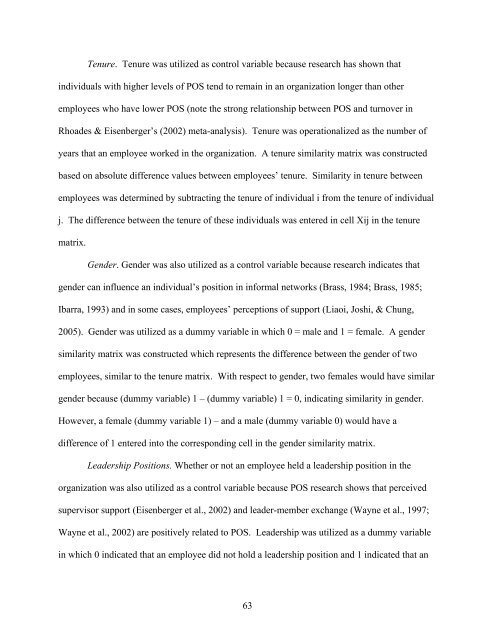a social influence analysis of perceived organizational support
a social influence analysis of perceived organizational support
a social influence analysis of perceived organizational support
Create successful ePaper yourself
Turn your PDF publications into a flip-book with our unique Google optimized e-Paper software.
Tenure. Tenure was utilized as control variable because research has shown that<br />
individuals with higher levels <strong>of</strong> POS tend to remain in an organization longer than other<br />
employees who have lower POS (note the strong relationship between POS and turnover in<br />
Rhoades & Eisenberger’s (2002) meta-<strong>analysis</strong>). Tenure was operationalized as the number <strong>of</strong><br />
years that an employee worked in the organization. A tenure similarity matrix was constructed<br />
based on absolute difference values between employees’ tenure. Similarity in tenure between<br />
employees was determined by subtracting the tenure <strong>of</strong> individual i from the tenure <strong>of</strong> individual<br />
j. The difference between the tenure <strong>of</strong> these individuals was entered in cell Xij in the tenure<br />
matrix.<br />
Gender. Gender was also utilized as a control variable because research indicates that<br />
gender can <strong>influence</strong> an individual’s position in informal networks (Brass, 1984; Brass, 1985;<br />
Ibarra, 1993) and in some cases, employees’ perceptions <strong>of</strong> <strong>support</strong> (Liaoi, Joshi, & Chung,<br />
2005). Gender was utilized as a dummy variable in which 0 = male and 1 = female. A gender<br />
similarity matrix was constructed which represents the difference between the gender <strong>of</strong> two<br />
employees, similar to the tenure matrix. With respect to gender, two females would have similar<br />
gender because (dummy variable) 1 – (dummy variable) 1 = 0, indicating similarity in gender.<br />
However, a female (dummy variable 1) – and a male (dummy variable 0) would have a<br />
difference <strong>of</strong> 1 entered into the corresponding cell in the gender similarity matrix.<br />
Leadership Positions. Whether or not an employee held a leadership position in the<br />
organization was also utilized as a control variable because POS research shows that <strong>perceived</strong><br />
supervisor <strong>support</strong> (Eisenberger et al., 2002) and leader-member exchange (Wayne et al., 1997;<br />
Wayne et al., 2002) are positively related to POS. Leadership was utilized as a dummy variable<br />
in which 0 indicated that an employee did not hold a leadership position and 1 indicated that an<br />
63
















